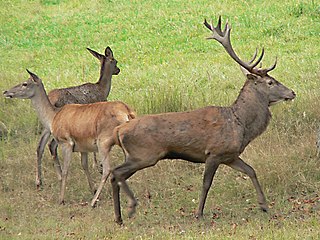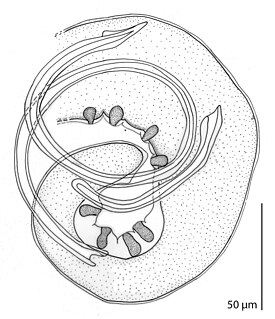Elaeophora is a genus of parasitic nematodes which live attached to the interior surfaces of major arteries, veins and/or heart chambers in various large mammal hosts. Infestation with Elaeophora species is referred to as elaeophorosis. The species of Elaeophora have been found in Africa, Asia, Europe, and North America. Despite the fact that they produce aneurysms in the arteries and heart of their hosts which measure up to 2 cm in diameter, overt clinical symptoms of infestation are seldom reported, with the notable exception of E. schneideri infestation in sheep, elk, and moose.
Isospora is a genus of internal parasites in the subclass Coccidia.

Gongylonema is a genus of thread-like nematode that was described by Molin in 1857. It is the only currently valid genus in the family Gongylonematidae, though the mysterious Spiruroides – usually placed in the Subuluridae, which are not closely related to Gongylonema among the Spiruria – might actually belong here. They are parasites of birds and mammals, transmitted by insects. Some 38 species are known, about 12 of which have been recorded in Europe.

Onchocerca is a genus of parasitic roundworm. It contains one human parasite – Onchocerca volvulus – which is responsible for the neglected disease Onchocerciasis, also known as "river blindness" because the infected humans tend to live near rivers where host black flies live. Over 40 million people are infected in Africa, Central America, and South America. Other species affect cattle, horses, etc.
Tetrameridae is a family of spirurian nematodes. It is the smallest of the large genera making up the bulk of the superfamily Habronematoidea. Like all nematodes, they have neither a circulatory nor a respiratory system. They are parasites, chiefly of birds and cetaceans.
Elaeophora elaphi is a nematode parasite found in the blood vessels of the liver in Red Deer in certain parts of Spain. The adult male measures 77 mm long and 549 µm wide, adult females are 91–109 mm long and 793-1049 µm wide, and microfilariae are 225 µm long. Though adult E. elaphi induce lesions in the blood vessels, and appear to activate the local immune response, they seldom cause overt clinical symptoms in their hosts.
Elaeophora sagitta is a parasitic nematode found in the heart, coronary arteries and pulmonary arteries of several ruminant species and African buffaloes in Africa. Infestation usually occurs without significant health effects in the Greater kudu, but may affect cardiac function in some other host species.

The Onchocercidae are a family of nematodes in the superfamily Filarioidea. This family includes some of the most devastating human parasitic diseases, such as lymphatic filariasis, onchocerciasis, loiasis, and other filariases.

Angiostrongylus is a genus of parasitic nematodes in the family Metastrongylidae.
Citellina is a genus of nematodes within the Oxyuridae family. Species of this genus typically parasitise marmots and ground squirrels of holarctic distribution. It was initially defined by Prendel in 1928, with the type species Citellina dispar
Hassalstrongylus lichtenfelsi is a nematode worm of the genus Hassalstrongylus that infects the marsh rice rat in Florida. The females cannot be distinguished from those of the other species in the marsh rice rat, H. forresteri and H. musculi.

Pterygodermatites is a genus of parasitic nematodes in the family Rictulariidae. Their life-cycle is complex. Species include:
Hepatocystis bainae is a species of parasitic alveolates belonging to the phylum Apicomplexia

Onchocerca tubingensis is the name of a nematode. It was discovered in 1974 and published by O. Bain und H. Schulz-Key in Tropenmedizin und Parasitologie and named after Tübingen. Red deer are the host of this parasite. The adult worms of Onchocerca tubingensis are found in subcutaneous nodules on the caudal part of the back, while the microfilariae are distributed on the ventral part of the body with maximum densities in the region of the sternum and with lower densities on the inner sides of the hindlegs. The infection rates of 94 red deer investigated in southern Germany during 1907–1974 were 23%.
Durikainema is a genus of two nematodes in the family Robertdollfusidae. Species have a head with a cuticular cephalic inflation, elongated papillae and amphids, and well-developed musculature. Characteristics of the males include a single spicule and a long attenuated tail. Durikainema species parasitize macropods. The genus was circumscribed in 1982 with the type species Durikainema macropi, a parasite of the eastern grey kangaroo. D. phascolarcti, parasite of the koala, was described in 1998.

Trichostrongyloidea is a superfamily of nematodes under the order Strongylida.

Odilia is a genus of nematode worms established by Marie-Claude Durette-Desset in 1973 that infect mostly murid rodents of the Australasian region (species of Melomys, Rattus and Uromys from mainland Australia and Tasmania.
Lipotropha is a genus of parasitic alveolates of the phylum Apicomplexa.

Cystidicolidae is a family of spirurian nematodes. It was created by Skrjabin in 1946. All members of the family are parasites of fish.

An oncomiracidium is the ciliated and free-living larva of a monogenean, a type of parasitic flatworm commonly found on fish. It is similar to the miracidium of Trematoda, but has sclerotised (hardened) hooklets not found in the latter.









